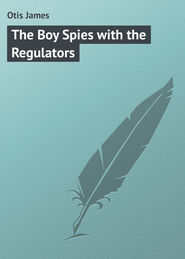По всем вопросам обращайтесь на: info@litportal.ru
(©) 2003-2025.
✖
The Boys of '98
Настройки чтения
Размер шрифта
Высота строк
Поля
The Cardenas land defences consisted of a battery in a stone fortification on the mole or quay, a battery of field-pieces, and of infantry armed with long-range rifles. The gunboats were equipped with rapid-fire guns.
Firing commenced at one o’clock, and when the Cardenas batteries were silenced at two in the afternoon, the Wilmington had sent 376 shells into them and the town. Her 4-inch guns had been fired 144 times. She had aimed 122 shots from her 6-pounders, and 110 from her 1-pounders, over six shots a minute.
When the Wilmington ceased firing she had moved up to within one thousand yards range of the Spanish guns, and there were only six inches of water under her keel. The Wilmington draws nine feet of water forward and ten and a half feet aft. When the soundings showed that she was almost touching, her guns were in full play, and the Spaniards had missed a beautiful opportunity. The Spanish gunners must have miscalculated her distance and misjudged her draught, else they would have done more effective work at a range of two thousand yards.
During the engagement, when the commander of the Winslow found that he could not approach close enough to the Spanish gunboats to use his torpedo-tubes to any advantage, he remained under fire. At that time he could have got out of harm’s way by taking shelter to the leeward of the Wilmington.
Captain Todd, from his post of duty in the conning-tower of the Wilmington, saw a Spanish shell, aimed for the torpedo-boat, do its deadly work. The shell struck the water, took an up-shoot, and exploded on the deck of the Winslow. There is little room for men anywhere on a torpedo boat, and if a shot strikes at all it is almost sure to hit a group. Such was the case in the Winslow. The exploding shell cost the lives of Ensign Bagley and four seamen; it also crippled the craft by wrecking her steam-steering gear. Later her captain and one of his crew were wounded by separate shots.
Ensign Bagley was killed outright, two of the group of five died on the deck of the disabled torpedo-boat, and the other two died while being removed to the Wilmington.
The signal, “Many wounded,” went up from the staff of the Winslow, and Passed Assistant Surgeon Cook of the Wilmington boarded the torpedo-boat.
The Hudson tied up to the Winslow and towed her out of danger, escaping unscathed. The wounded men were tenderly cared for on the cruiser, and that night the revenue cutter steamed out of Cardenas Bay, bearing the dead and wounded to Key West.
William O’Hearn, of Brooklyn, N. Y., one of the Winslow’s crew, thus tells his story of the battle to a newspaper correspondent:
“From the very beginning,” he said, “I think every man on the boat believed that we could not escape being sunk, and that is what would have happened had it not been for the bravery of the boys on the Hudson, who worked for over an hour under the most terrific fire to get us out of range.”
“Were you ordered to go in there?” he was asked.
“Yes; just before we were fired upon the order was given from the Wilmington.”
“Was it a signal order?”
“No; we were near enough to the Wilmington so that they shouted it to us from the deck, through the megaphone.”
“Do you remember the words of the commander who gave them?”
“I don’t know who shouted the order; but the words as I remember them were, ‘Mr. Bagley, go in and see what gunboats there are.’ We started at once towards the Cardenas dock, and the firing began soon after.
“The first thing I saw,” continued O’Hearn, “was a shot fired from a window or door in the second story of the storehouse just back of the dock where the Spanish gunboats were lying. A shell then went hissing over our heads. Then the firing began from the gunboat at the wharf, and from the shore. The effect of shell and heavy shot the first time a man is under fire is something terrible.
“First you hear that awful buzzing or whizzing, and then something seems to strike you in the face and head. I noticed that at first the boys threw their hands to their heads every time a shell went over; but they soon came so fast and so close that it was a roaring, shrieking, crashing hell.
“I am the water-tender, and my place is below, but everybody went on deck when the battle began. John Varvares, the oiler, John Denif and John Meek, the firemen, were on watch with me, and had they remained below they would not have been killed.
“After the firing began I went below again to attend to the boiler, and a few minutes later a solid shot came crashing through the side of the boat and into the boiler, where it exploded and destroyed seventy of the tubes.
“At first it stunned me. When the shell burst in the boiler it threw both the furnace doors open, and the fuse from the shell struck my feet. It was a terrible crash, and the boiler-room was filled with dust and steam. For several seconds I was partially stunned, and my ears rang so I could hear nothing. I went up on the deck to report to Captain Bernadou.
“I saw him near the forecastle gun, limping about with a towel wound around his left leg. He was shouting, and the noise of all the guns was like continuous thunder. ‘Captain,’ I cried, ‘the forward boiler is disabled. A shell has gone through it.’
“ ‘Get out the hose,’ he said, and turned to the gun again. I made my way to the boiler-room, in a few minutes went up on the deck again, and the fighting had grown hotter than ever. Several of the men were missing, and I looked around.
“Lying all in a heap on the after-deck in the starboard quarter, near the after conning-tower, I saw five of our men where they had wilted down after the shell struck them. In other places were men lying groaning, or dragging themselves about, wounded and covered with blood. There were big red spots on the deck, which was strewn with fragments and splinters.
“I went to where the five men were lying, and saw that all were not dead. John Meek could speak and move one hand slightly. I put my face down close to his.
“ ‘Can I do anything for you, John?’ I asked, and he replied, ‘No, Jack, I am dying; good-bye,’ and he asked me to grasp his hand. ‘Go help the rest,’ he whispered, gazing with fixed eyes toward where Captain Bernadou was still firing the forward gun. The next minute he was dead.
“Ensign Bagley was lying on the deck nearly torn to pieces, and the bodies of the other three were on top of him. The coloured cook was a little apart from the others, mangled, and in a cramped position. We supposed he was dead, and covered him up the same as the others. Nearly half an hour after that we heard him calling, and saw that he was making a slight movement under the clothes. I went up to him, and he said:
“ ‘Oh, boys, for God’s sake move me. I am lying over the boiler and burning up.’
“The deck was very hot, and his flesh had been almost roasted. He complained that his neck was cramped, but did not seem to feel his terrible wound. We moved him into an easier position, and gave him some water.
“ ‘Thank you, sir,’ he said, and in five seconds he was dead.”
Ensign Bagley had been fearfully wounded by a shot, which practically tore through his body. He sank over the rail, and was grasped by one of the enlisted men, named Reagan, who lifted him up and placed him on the deck.
The young officer, realising that the wound was fatal, and that he had only a short time to live, allowed no murmur of complaint or cry of pain to escape him, but opened his eyes, stared at the sailor, and simply said:
“Thank you, Reagan.”
These were the last words he spoke.
May 12. The forts of San Juan, the capital of Porto Rico, were bombarded by a portion of Rear-Admiral Sampson’s fleet on Thursday morning, May 12th. The vessels taking part in the action were the battle-ships New York, Iowa, Indiana, the cruisers Detroit and Montgomery, and the monitors Terror and Amphitrite.
The engagement began at 5.15 and ended at 8.15 A. M., resulting in a loss to the Americans of one killed and seven wounded, and the death of one from prostration by heat. The Spanish loss, as reported by cable to Madrid, was five killed and forty-three wounded.
Admiral Sampson’s orders were to refrain from making any land attack so long as the batteries on shore did not attempt to molest his ships; but in case the Spaniards fired on his vessels, to destroy the offending fortifications.
These orders were not issued until the Spanish fire at different Cuban ports became so irritating to the American bluejackets that discipline was, in a measure, threatened; but as soon as the men learned that they were no longer to remain passive targets for the Spaniards, but were to return any shots against them, all grumbling against inaction ceased.
It was not Admiral Sampson’s original intention to attack San Juan. He was looking for bigger game than the poorly defended Porto Rican capital. His orders from the Navy Department were to find and capture or destroy the Spanish squadron that was en route from the Cape Verde Islands, and it was this business that took him into the neighbourhood of San Juan, he being desirous of learning if the Spanish squadron were there.
The fleet arrived off San Juan before daybreak on Thursday. The tug Wampatuck was ordered to take soundings in the channel, and at once proceeded to do so. She was fully half a mile ahead of the fleet when she entered the channel, and those aboard of her kept the lead going at a lively rate.
It is supposed that Admiral Sampson had no intention at that time of entering the harbour itself, his object, when he found that the Spanish squadron was not at San Juan, being to learn for future use exactly how much water there was in the channel, and if any attempt had been made to block the way.
At all events, while the Wampatuck was engaged in this work she was seen by the sentries at the Morro, and a few minutes later was fired on.
Then, and not until then, did Admiral Sampson determine to teach the Spaniards a lesson regarding the danger of firing on the American flag.
“Quarters!” rang out aboard the war-ships almost before the report of the Morro gun had died away, the flag-ship having signalled for action.
The Iowa opened the bombardment with her big 12-inch gun, the missile striking Morro Castle squarely, and knocking a great hole in the masonry.
Then the Indiana sent a 13-inch projectile from the forward turret, and one after the other, with but little loss of time, the remaining vessels of the fleet aided in the work of destruction.
The French war-ship Admiral Rigault de Genoailly was at anchor in the harbour, and a shell exploded within a few hundred feet of where she lay, but worked no injury.
The French officers thus reported the action:
“The American gunners were generally accurate in their firing, while the marksmanship of the Spaniards was inferior. Some of the American shells, however, passed over the fortifications into the city, where they did terrible damage, crashing straight through rows of buildings before exploding, and there killing many citizens.
“The fortifications were irreparably injured. Repeatedly masses of masonry were blown skyward by the shells from the American guns. Fragments from one shell struck the commandante’s residence, which was situated near the fortifications, damaging it terrifically.”
Firing commenced at one o’clock, and when the Cardenas batteries were silenced at two in the afternoon, the Wilmington had sent 376 shells into them and the town. Her 4-inch guns had been fired 144 times. She had aimed 122 shots from her 6-pounders, and 110 from her 1-pounders, over six shots a minute.
When the Wilmington ceased firing she had moved up to within one thousand yards range of the Spanish guns, and there were only six inches of water under her keel. The Wilmington draws nine feet of water forward and ten and a half feet aft. When the soundings showed that she was almost touching, her guns were in full play, and the Spaniards had missed a beautiful opportunity. The Spanish gunners must have miscalculated her distance and misjudged her draught, else they would have done more effective work at a range of two thousand yards.
During the engagement, when the commander of the Winslow found that he could not approach close enough to the Spanish gunboats to use his torpedo-tubes to any advantage, he remained under fire. At that time he could have got out of harm’s way by taking shelter to the leeward of the Wilmington.
Captain Todd, from his post of duty in the conning-tower of the Wilmington, saw a Spanish shell, aimed for the torpedo-boat, do its deadly work. The shell struck the water, took an up-shoot, and exploded on the deck of the Winslow. There is little room for men anywhere on a torpedo boat, and if a shot strikes at all it is almost sure to hit a group. Such was the case in the Winslow. The exploding shell cost the lives of Ensign Bagley and four seamen; it also crippled the craft by wrecking her steam-steering gear. Later her captain and one of his crew were wounded by separate shots.
Ensign Bagley was killed outright, two of the group of five died on the deck of the disabled torpedo-boat, and the other two died while being removed to the Wilmington.
The signal, “Many wounded,” went up from the staff of the Winslow, and Passed Assistant Surgeon Cook of the Wilmington boarded the torpedo-boat.
The Hudson tied up to the Winslow and towed her out of danger, escaping unscathed. The wounded men were tenderly cared for on the cruiser, and that night the revenue cutter steamed out of Cardenas Bay, bearing the dead and wounded to Key West.
William O’Hearn, of Brooklyn, N. Y., one of the Winslow’s crew, thus tells his story of the battle to a newspaper correspondent:
“From the very beginning,” he said, “I think every man on the boat believed that we could not escape being sunk, and that is what would have happened had it not been for the bravery of the boys on the Hudson, who worked for over an hour under the most terrific fire to get us out of range.”
“Were you ordered to go in there?” he was asked.
“Yes; just before we were fired upon the order was given from the Wilmington.”
“Was it a signal order?”
“No; we were near enough to the Wilmington so that they shouted it to us from the deck, through the megaphone.”
“Do you remember the words of the commander who gave them?”
“I don’t know who shouted the order; but the words as I remember them were, ‘Mr. Bagley, go in and see what gunboats there are.’ We started at once towards the Cardenas dock, and the firing began soon after.
“The first thing I saw,” continued O’Hearn, “was a shot fired from a window or door in the second story of the storehouse just back of the dock where the Spanish gunboats were lying. A shell then went hissing over our heads. Then the firing began from the gunboat at the wharf, and from the shore. The effect of shell and heavy shot the first time a man is under fire is something terrible.
“First you hear that awful buzzing or whizzing, and then something seems to strike you in the face and head. I noticed that at first the boys threw their hands to their heads every time a shell went over; but they soon came so fast and so close that it was a roaring, shrieking, crashing hell.
“I am the water-tender, and my place is below, but everybody went on deck when the battle began. John Varvares, the oiler, John Denif and John Meek, the firemen, were on watch with me, and had they remained below they would not have been killed.
“After the firing began I went below again to attend to the boiler, and a few minutes later a solid shot came crashing through the side of the boat and into the boiler, where it exploded and destroyed seventy of the tubes.
“At first it stunned me. When the shell burst in the boiler it threw both the furnace doors open, and the fuse from the shell struck my feet. It was a terrible crash, and the boiler-room was filled with dust and steam. For several seconds I was partially stunned, and my ears rang so I could hear nothing. I went up on the deck to report to Captain Bernadou.
“I saw him near the forecastle gun, limping about with a towel wound around his left leg. He was shouting, and the noise of all the guns was like continuous thunder. ‘Captain,’ I cried, ‘the forward boiler is disabled. A shell has gone through it.’
“ ‘Get out the hose,’ he said, and turned to the gun again. I made my way to the boiler-room, in a few minutes went up on the deck again, and the fighting had grown hotter than ever. Several of the men were missing, and I looked around.
“Lying all in a heap on the after-deck in the starboard quarter, near the after conning-tower, I saw five of our men where they had wilted down after the shell struck them. In other places were men lying groaning, or dragging themselves about, wounded and covered with blood. There were big red spots on the deck, which was strewn with fragments and splinters.
“I went to where the five men were lying, and saw that all were not dead. John Meek could speak and move one hand slightly. I put my face down close to his.
“ ‘Can I do anything for you, John?’ I asked, and he replied, ‘No, Jack, I am dying; good-bye,’ and he asked me to grasp his hand. ‘Go help the rest,’ he whispered, gazing with fixed eyes toward where Captain Bernadou was still firing the forward gun. The next minute he was dead.
“Ensign Bagley was lying on the deck nearly torn to pieces, and the bodies of the other three were on top of him. The coloured cook was a little apart from the others, mangled, and in a cramped position. We supposed he was dead, and covered him up the same as the others. Nearly half an hour after that we heard him calling, and saw that he was making a slight movement under the clothes. I went up to him, and he said:
“ ‘Oh, boys, for God’s sake move me. I am lying over the boiler and burning up.’
“The deck was very hot, and his flesh had been almost roasted. He complained that his neck was cramped, but did not seem to feel his terrible wound. We moved him into an easier position, and gave him some water.
“ ‘Thank you, sir,’ he said, and in five seconds he was dead.”
Ensign Bagley had been fearfully wounded by a shot, which practically tore through his body. He sank over the rail, and was grasped by one of the enlisted men, named Reagan, who lifted him up and placed him on the deck.
The young officer, realising that the wound was fatal, and that he had only a short time to live, allowed no murmur of complaint or cry of pain to escape him, but opened his eyes, stared at the sailor, and simply said:
“Thank you, Reagan.”
These were the last words he spoke.
May 12. The forts of San Juan, the capital of Porto Rico, were bombarded by a portion of Rear-Admiral Sampson’s fleet on Thursday morning, May 12th. The vessels taking part in the action were the battle-ships New York, Iowa, Indiana, the cruisers Detroit and Montgomery, and the monitors Terror and Amphitrite.
The engagement began at 5.15 and ended at 8.15 A. M., resulting in a loss to the Americans of one killed and seven wounded, and the death of one from prostration by heat. The Spanish loss, as reported by cable to Madrid, was five killed and forty-three wounded.
Admiral Sampson’s orders were to refrain from making any land attack so long as the batteries on shore did not attempt to molest his ships; but in case the Spaniards fired on his vessels, to destroy the offending fortifications.
These orders were not issued until the Spanish fire at different Cuban ports became so irritating to the American bluejackets that discipline was, in a measure, threatened; but as soon as the men learned that they were no longer to remain passive targets for the Spaniards, but were to return any shots against them, all grumbling against inaction ceased.
It was not Admiral Sampson’s original intention to attack San Juan. He was looking for bigger game than the poorly defended Porto Rican capital. His orders from the Navy Department were to find and capture or destroy the Spanish squadron that was en route from the Cape Verde Islands, and it was this business that took him into the neighbourhood of San Juan, he being desirous of learning if the Spanish squadron were there.
The fleet arrived off San Juan before daybreak on Thursday. The tug Wampatuck was ordered to take soundings in the channel, and at once proceeded to do so. She was fully half a mile ahead of the fleet when she entered the channel, and those aboard of her kept the lead going at a lively rate.
It is supposed that Admiral Sampson had no intention at that time of entering the harbour itself, his object, when he found that the Spanish squadron was not at San Juan, being to learn for future use exactly how much water there was in the channel, and if any attempt had been made to block the way.
At all events, while the Wampatuck was engaged in this work she was seen by the sentries at the Morro, and a few minutes later was fired on.
Then, and not until then, did Admiral Sampson determine to teach the Spaniards a lesson regarding the danger of firing on the American flag.
“Quarters!” rang out aboard the war-ships almost before the report of the Morro gun had died away, the flag-ship having signalled for action.
The Iowa opened the bombardment with her big 12-inch gun, the missile striking Morro Castle squarely, and knocking a great hole in the masonry.
Then the Indiana sent a 13-inch projectile from the forward turret, and one after the other, with but little loss of time, the remaining vessels of the fleet aided in the work of destruction.
The French war-ship Admiral Rigault de Genoailly was at anchor in the harbour, and a shell exploded within a few hundred feet of where she lay, but worked no injury.
The French officers thus reported the action:
“The American gunners were generally accurate in their firing, while the marksmanship of the Spaniards was inferior. Some of the American shells, however, passed over the fortifications into the city, where they did terrible damage, crashing straight through rows of buildings before exploding, and there killing many citizens.
“The fortifications were irreparably injured. Repeatedly masses of masonry were blown skyward by the shells from the American guns. Fragments from one shell struck the commandante’s residence, which was situated near the fortifications, damaging it terrifically.”











